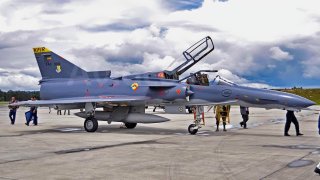Israel Wanted the Mirage 5 Fighter from France. They Got the IAI Kfir Instead
The Kfir entered service with the Israeli Air Force in 1975. Two years later, the aircraft entered combat for the first time, striking a training camp in Lebanon.
Summary: The Israel Aerospace Industries Kfir, a multifaceted fighter jet with a complex background, exemplifies the ingenuity and determination of the Israeli Air Force (IAF) amid geopolitical challenges. Initially relying on the French Mirage IIIC for air superiority missions, Israel sought an aircraft with greater versatility, leading to the development of the Mirage 5 by Dassault. However, a sudden French arms embargo forced Israel to undertake industrial espionage to secure the necessary technical specifications for the Mirage 5, culminating in the reverse-engineered IAI Nesher, which eventually evolved into the Kfir. Powered by a Bedek-built General Electric J79 engine, the Kfir boasted impressive specs, including a maximum speed of 1,520 mph and a wide array of armaments.
Why the Kfir Fighter Was Born
The Israel Aerospace Industries Kfir (“Lion Cub”) is an all-weather multi-role fighter with a peculiar history.
Before the development of the Kfir, the Israeli Air Force relied heavily on the Dassault Mirage IIIC, a French delta-winged fighter. In the 1960s, the Israelis and French enjoyed a harmonious relationship. The Mirage IIIC was in fact tailored to the needs of the IAF, and the Israelis found the aircraft satisfactory, at least with respect to air superiority missions.
But the Mirage IIIC’s limited range meant the jet could not conduct many of the ground-attack missions the Israelis wanted to execute. The Israelis sought a more versatile airframe, so they pushed their French allies to begin developing the Mirage 5.
The Mirage 5
Dassault, the French aerospace manufacturer responsible for the Mirage IIIC, began working on a modified version – an aircraft that would become the Mirage 5.
Dassault removed the avionics that were located behind the IIIC’s cockpit, allowing for increased fuel capacity and reduced maintenance costs. The result was a fair-weather, ground-attack version of the Mirage IIIC.
By 1968, Dassault had built 50 Mirage 5s – all intended for Israel, which had paid for the airframes. But geopolitical circumstances changed swiftly. Newly inaugurated French President Charles de Gaulle made efforts to repair relations between France and the Arab world. De Gaulle retracted the French claim on Algeria, and he cut ties with Israel.
The French government imposed an arms embargo against Israel, which would never receive the Mirage 5s they had already paid for. Israel did not sit idly by – it could not afford to lose its air superiority advantage to adversaries who were being equipped with increasingly sophisticated Soviet fighters.
Industrial Espionage
The Israelis used spies to gather the technical specifications for the Mirage 5 airframe and engine. With the stolen tech specs, Israel was able to reverse-engineer the Mirage 5, resulting in the IAI Nesher. The Nesher itself was upgraded, resulting in the Kfir.
The Kfir used a Bedek-built General Electric J79 engine, which provided 11,900 pounds of thrust dry, and 17,900 pounds of thrust with afterburners. The engine allowed for a maximum speed of 1,520 miles per hour and a combat range of 477 miles. The Kfir’s service ceiling was 58,010 feet, with a rate of climb measuring 45,900 feet per minute.
For armament, the Kfir carried two Rafael-built 30mm DEFA 553 cannons with 140 rounds of ammunition each; a variety of unguided air-to-ground rockets; missiles including the AIM-9 Sidewinder, Shafrir Aam, Shrike Anti-Radiation Missile, and AGM-65 Maverick; plus, plenty of bombs. In all, the Kfir could carry a payload exceeding six tons.
Entering Service With the IAF
The Kfir entered service with the Israeli Air Force in 1975. Two years later, the aircraft entered combat for the first time, striking a training camp in Lebanon. In 1979, the Kfir earned its only air-to-air victory when it shot down a Syrian MiG-21. Despite the lengths to which the Israelis went to obtain and develop the Kfir, the jet was not the IAF’s primary fighter for very long. By the time Israel invaded Lebanon in 1982, it relied on the U.S. for air power, and the IAF imported the F-15 Eagle and F-16 Fighting Falcon for air superiority roles. The Kfir was relegated to secondary status, conducting unescorted strike missions. By the 1990s, the Israelis began retiring the Kfir.
The Kfir is still in service today in air forces that rely on outdated airframes, including Colombia, Ecuador, and Sri Lanka.
The Kfir is curious for its notable development. Its less remarkable operational history is somewhat anticlimactic.
About the Author: Harrison Kass
Harrison Kass is a defense and national security writer with over 1,000 total pieces on issues involving global affairs. An attorney, pilot, guitarist, and minor pro hockey player, Harrison joined the US Air Force as a Pilot Trainee but was medically discharged. Harrison holds a BA from Lake Forest College, a JD from the University of Oregon, and an MA from New York University. Harrison listens to Dokken.


